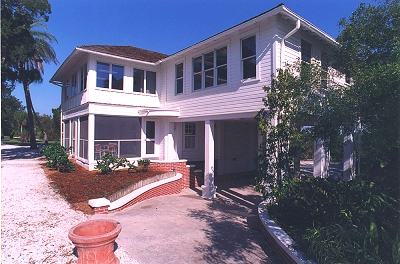 |
|
The Oaks, Osprey Point and Historic Spanish Point
By Harold Bubil. Sarasiota herald Tribune.
Published: Sunday, January 17, 2010 at 1:00 a.m.
Bertha Palmer lived in The Oaks, but that is where it can get confusing.
Her house, a remodeled hunting lodge that she bought in 1910, was called The Oaks. But it
is not in Historic Spanish Point. Long since demolished, it was located in what is now the
bay side of the luxurious, gated subdivision known as The Oaks, immediately north of the
Osprey historical site and gardens. |
The house called The Oaks was the crown jewel of Palmer's Osprey Estate, called Osprey
Point. Palmer brought Thomas Reed Martin down from Chicago to remodel and expand it from
four rooms to 31, said Palmer scholar Hope Black. (Martin was to stay in town and become
its first standout architect, designing about 300 houses during his long career.) The
columned front porch looked across Little Sarasota Bay to Midnight Pass, which in about 75
years would close up.
Osprey Point had about 350 acres, and included the garden area and old Webb family
pioneer-era homestead that is now called Historic Spanish Point.
“The Oaks … was not in what is today Historic Spanish Point,” said Linda
Mansperger of HSP. The hunting lodge, she said, “looked a lot like the Guptill House
here at Historic Spanish Point. It was a small, wooden, two-story home.
“It was north of what is now Historic Spanish Point. My understanding is that it was
torn down by the family long before Historic Spanish Point was listed in the National
Register, which was 1975. No one wanted to live in it and maintain it, as it was quite
large.
“Osprey Point was a working farm with a village area where her workers lived,”
said Mansperger. “She (Palmer) had her own electric plant, and they grew the food
they needed to live on. She had livestock, she had poultry, separate buildings for the
laborers. I don't want to use the word ‘plantation,' but it wasn't just her house. It
really was a working estate. The Oaks was her home, and the other little pioneer buildings
(the White and Guptill houses) from the Webb homestead were used as cottages for other
family members or for winter guests when they came.”
ringlingdocents.org
|